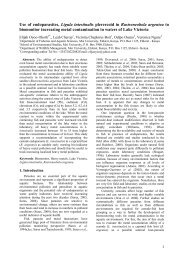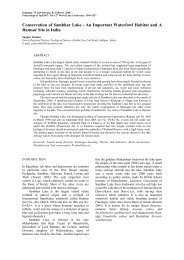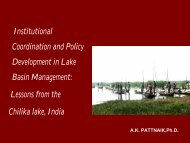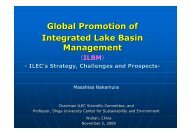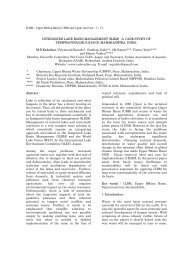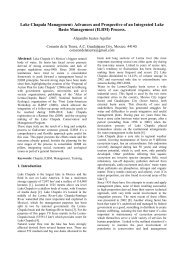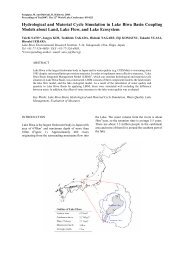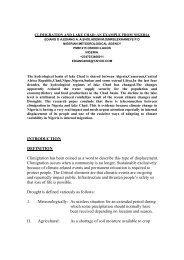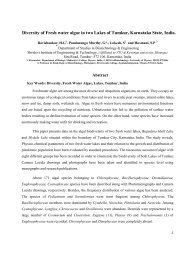Management of Haors, Baors, and Beels in Bangladesh Lessons for ...
Management of Haors, Baors, and Beels in Bangladesh Lessons for ...
Management of Haors, Baors, and Beels in Bangladesh Lessons for ...
You also want an ePaper? Increase the reach of your titles
YUMPU automatically turns print PDFs into web optimized ePapers that Google loves.
controlled by the M<strong>in</strong>istry <strong>of</strong> L<strong>and</strong> (MOL). Poor fishers<br />
are effectively excluded from the best fisheries as they<br />
cannot af<strong>for</strong>d to pay <strong>for</strong> the lease. The Community Based<br />
Fisheries <strong>Management</strong> (CBFM) project implemented from<br />
1996 to 2006 by the <strong>in</strong>ternational research orgnization the<br />
WorldFish Center, <strong>in</strong> partnership with the Government <strong>of</strong><br />
<strong>Bangladesh</strong> Department <strong>of</strong> Fisheries (DoF) <strong>and</strong> local NGOs,<br />
<strong>in</strong> an action research project which has developed a series<br />
<strong>of</strong> community based fisheries management approaches<br />
(fisher-led, community-led <strong>and</strong> women led) <strong>for</strong> ensur<strong>in</strong>g<br />
equitable access to fisheries resources <strong>for</strong> community based<br />
management groups.<br />
Over a ten-year period, the CBFM project has established<br />
community control over 116 water bodies. Over 130 <strong>of</strong>ficially<br />
recognized, poverty-focused, Community Based<br />
Organizations (CBOs) are <strong>in</strong>volved <strong>in</strong> the management<br />
<strong>of</strong> these water bodies. However, <strong>in</strong> return <strong>for</strong> access, the<br />
CBOs must embrace the pr<strong>in</strong>cipals <strong>of</strong> susta<strong>in</strong>able fisheries<br />
management.<br />
One <strong>of</strong> the ma<strong>in</strong> actions <strong>of</strong> CBFM-2 has been to establish<br />
fish sanctuary-no fish<strong>in</strong>g zones where a proportion <strong>of</strong> the<br />
fish <strong>in</strong> the water body are allowed to stay safely even when<br />
surround<strong>in</strong>g water levels are at their lowest<br />
CWBMP<br />
In <strong>Bangladesh</strong> there are 8 Ecological Critical Areas (ECA).<br />
Those ECAs are mostly wetl<strong>and</strong>s, viz.<br />
1. Hakaluki Haor<br />
2. Cox’s Bazar Beach<br />
3. Sonadia Isl<strong>and</strong><br />
4. St. Mart<strong>in</strong>’s Isl<strong>and</strong><br />
5. Marjut Beel<br />
6. Gulshn-Baridhara Lake<br />
7. Tanguar Haor<br />
8. Periphery <strong>of</strong> Sundarbans<br />
The project Costal <strong>and</strong> wetl<strong>and</strong> Biodiversity <strong>Management</strong><br />
Project (CWBMP) aims to implement the ECA legislation<br />
through the participation <strong>of</strong> local community <strong>and</strong> alternative<br />
livelihood options. The project has been implemented<br />
s<strong>in</strong>ce 2006 <strong>in</strong> Hakaluki Haor, Cox’s Bazar Beach, Sonadia<br />
Isl<strong>and</strong> <strong>and</strong> St. Mart<strong>in</strong>’s Isl<strong>and</strong>. Village Conservation Groups<br />
(VCGs) <strong>for</strong>med <strong>for</strong> the objectives <strong>of</strong> the projects implement<strong>in</strong>g<br />
different activities <strong>in</strong>clud<strong>in</strong>g Alternative Income<br />
Generation, swamp plantation, mangrove plantation, n<strong>of</strong>ish<strong>in</strong>g<br />
zone, etc.<br />
<strong>Lessons</strong> <strong>for</strong> Lake Bas<strong>in</strong> <strong>Management</strong><br />
Tools used <strong>in</strong> wetl<strong>and</strong> development<br />
Through the implementation <strong>of</strong> different project <strong>and</strong> program<br />
different successful tools have been developed <strong>for</strong><br />
the conservation <strong>and</strong> management lakes, such as,<br />
• Participatory Action Plan Development<br />
• Community based Fisheries Resource <strong>Management</strong><br />
• Community based Fish sanctuary<br />
• Restoration <strong>of</strong> Swamp <strong>for</strong>est, etc.<br />
• Cultivation <strong>in</strong> Hydrophonic<br />
Participatory Action Plan Development (CNRS 2003)<br />
PAPD is a process, which can create an enabl<strong>in</strong>g environment<br />
among the community people to build their consensus.<br />
The process is so structured that by go<strong>in</strong>g through a<br />
series <strong>of</strong> steps, consensus could be built over what actions<br />
were needed to better manage natural resources, particularly<br />
common resources. In <strong>Bangladesh</strong> the practice <strong>of</strong> PAPD<br />
is highly appreciated to make community participat<strong>in</strong>g the<br />
management <strong>of</strong> wetl<strong>and</strong>s. PAPD was practiced successfully<br />
<strong>in</strong> management <strong>of</strong> Hail Haor, Hakaluki Haor, Arial Beel,<br />
etc. The PAPD method is described briefly <strong>in</strong> Annex I.<br />
Community based Fisheries Resource <strong>Management</strong><br />
Community based fisheries resource management is a<br />
community consensus where the community themselves<br />
develop some norms <strong>and</strong> practices <strong>for</strong> the betterment <strong>of</strong><br />
the fisheries resources as well as the security <strong>of</strong> their livelihood.<br />
The norm <strong>in</strong>cludes maximum size <strong>of</strong> nets, no fish<strong>in</strong>g<br />
periods, avoid<strong>in</strong>g harmful agricultural practices, etc.<br />
Community based fisheries resource management has<br />
been practiced <strong>in</strong> number <strong>of</strong> projects <strong>in</strong>clud<strong>in</strong>g CBFM-2<br />
<strong>in</strong> around 116 wetl<strong>and</strong>s over country (WorldFish Center).<br />
MACH project <strong>and</strong> ECFC project have also practiced the<br />
method. The method <strong>of</strong> community based fisheries resource<br />
management is briefly described <strong>in</strong> Annex II.<br />
Community based Fish Sanctuary<br />
Community based fisheries sanctuary has tremendous success<br />
stories. Resulted from the 4 th Fisheries, MACH Project<br />
<strong>and</strong> CBFMS to there are around hundreds community<br />
based fish sanctuaries <strong>in</strong> various sizes over the country. The<br />
community based fish sanctuary is community announced<br />
<strong>and</strong> practices project areas that is a no fish<strong>in</strong>g zone with<br />
a core area <strong>and</strong> a buffer zone. Community also facilitated<br />
some traditional techniques <strong>for</strong> the welfare <strong>of</strong> fish. Those<br />
sanctuaries are breed<strong>in</strong>g grounds <strong>and</strong> ensure the brood<br />
stock that <strong>in</strong>creases the fisheries resources. As an example<br />
<strong>of</strong> a Community based Fish Sanctuary the Baikka Beel is<br />
described <strong>in</strong> Annex III (CNRS 2007).<br />
5



